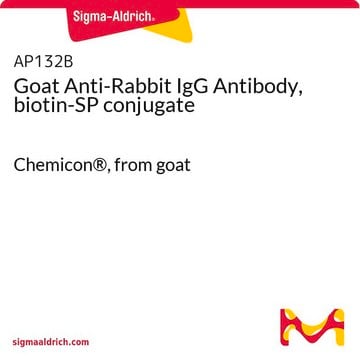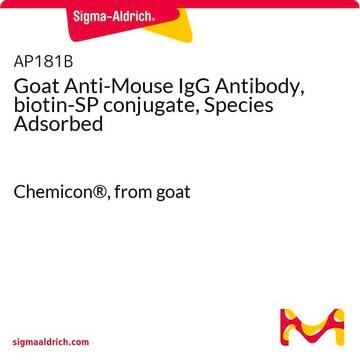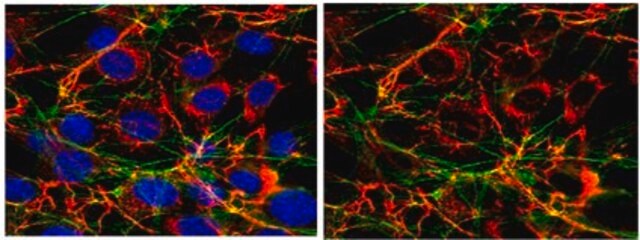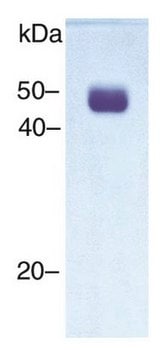AP182B
Donkey Anti-Rabbit IgG Antibody, biotin-SP conjugate, Species Adsorbed
Chemicon®, from donkey
Sign Into View Organizational & Contract Pricing
All Photos(1)
About This Item
UNSPSC Code:
12352203
eCl@ss:
32160702
NACRES:
NA.46
Recommended Products
biological source
donkey
Quality Level
conjugate
biotin conjugate
antibody form
affinity purified immunoglobulin
antibody product type
secondary antibodies
clone
polyclonal
species reactivity
rabbit
manufacturer/tradename
Chemicon®
technique(s)
ELISA: suitable
western blot: suitable
shipped in
wet ice
target post-translational modification
unmodified
General description
Immunoglobulin G (IgG), is one of the most abundant proteins in human serum with normal levels between 8-17 mg/mL in adult blood. IgG is important for our defence against microorganisms and the molecules are produced by B lymphocytes as a part of our adaptive immune response. The IgG molecule has two separate functions; to bind to the pathogen that elicited the response and to recruit other cells and molecules to destroy the antigen. The variability of the IgG pool is generated by somatic recombination and the number of specificities in an individual at a given time point is estimated to be 1011 variants.
Specificity
Rabbit IgG
Application
Donkey anti-Rabbit IgG Antibody, biotin-SP conjugate, Species Adsorbed detects level of Donkey Rabbit IgG & has been published & validated for use in ELISA & WB.
EIA: 1:50,000-1:100,000 Western blots using enzyme-conjugated streptavidin: 1:10,000-1:100,000. Immunohistochemistry: 1:500-1:5,000 Flow cytometry: 1:200-1:1,000 Fluorescence Immunohisto/cytochemistry: 1:200-1:1,1000 Optimal working dilutions must be determined by end user.
Research Category
Secondary & Control Antibodies
Secondary & Control Antibodies
Research Sub Category
Secondary Antibodies Adsorbed for Dual Labeling
Secondary Antibodies Adsorbed for Dual Labeling
Physical form
Lyophilized. Buffer = 0.01 M Sodium Phosphate, 0.15 M NaCl, pH 7.1 with 15 mg/mL BSA, and 0.1% sodium azide.
RECONSTITUTION:
Reconstitute with 500 μL of sterile distilled water.
RECONSTITUTION:
Reconstitute with 500 μL of sterile distilled water.
Storage and Stability
Maintain lyophilized product at 2-8°C for up to 12 months. After reconstitution the product is stable for several weeks at 2-8°C as an undiluted liquid. For extended storage after reconstitution, add an equal volume of glycerol to make a final concentration of 50% glycerol followed by storage at -20°C in undiluted aliquots for up to 12 months. Please note the concentration of protein (and buffer salts) will decrease to one-half of the original after the addition of glycerol. Avoid repeated freeze/thaw cycles.
Legal Information
CHEMICON is a registered trademark of Merck KGaA, Darmstadt, Germany
Disclaimer
Unless otherwise stated in our catalog or other company documentation accompanying the product(s), our products are intended for research use only and are not to be used for any other purpose, which includes but is not limited to, unauthorized commercial uses, in vitro diagnostic uses, ex vivo or in vivo therapeutic uses or any type of consumption or application to humans or animals.
Not finding the right product?
Try our Product Selector Tool.
hcodes
pcodes
Hazard Classifications
Aquatic Chronic 3
Storage Class
11 - Combustible Solids
wgk_germany
WGK 3
Certificates of Analysis (COA)
Search for Certificates of Analysis (COA) by entering the products Lot/Batch Number. Lot and Batch Numbers can be found on a product’s label following the words ‘Lot’ or ‘Batch’.
Already Own This Product?
Find documentation for the products that you have recently purchased in the Document Library.
Mei-Xiang Zhan et al.
Journal of pain research, 14, 1201-1214 (2021-05-13)
Ulinastatin, a broad-spectrum serine protease inhibitor, has been widely used to treat various diseases clinically. However, so far, the antinociceptive effect of ulinastatin remains less studied experimentally and the underlying mechanisms of ulinastatin for pain relief remain unclear. This study
Yoshiko Nakamura et al.
Cell metabolism, 25(2), 322-334 (2017-01-10)
Hypothalamic neuropeptide Y (NPY) elicits hunger responses to increase the chances of surviving starvation: an inhibition of metabolism and an increase in feeding. Here we elucidate a key central circuit mechanism through which hypothalamic NPY signals drive these hunger responses.
Long-term exercise is a potent trigger for ?FosB induction in the hippocampus along the dorso-ventral axis.
Nishijima, T; Kawakami, M; Kita, I
Testing null
Bei Liu et al.
International journal of ophthalmology, 10(7), 1034-1039 (2017-07-22)
To investigate the expression differences of transforming growth factor-β2 (TGF-β2), basic fibroblast growth factor (bFGF) and intercellular cell-adhesion molecule-1 (ICAM-1) in lens epithelial cells (LECs) of complicated cataract with silicone oil tamponade and age-related cataract. Totally 150 eyes of 150
Gene expression changes in the olfactory bulb of mice induced by exposure to diesel exhaust are dependent on animal rearing environment.
Yokota, S; Hori, H; Umezawa, M; Kubota, N; Niki, R; Yanagita, S; Takeda, K
Testing null
Our team of scientists has experience in all areas of research including Life Science, Material Science, Chemical Synthesis, Chromatography, Analytical and many others.
Contact Technical Service








